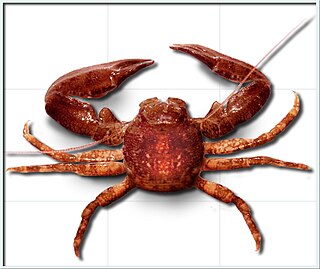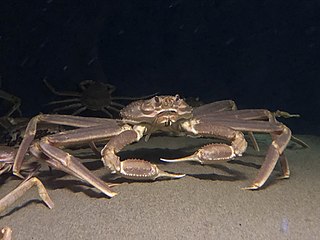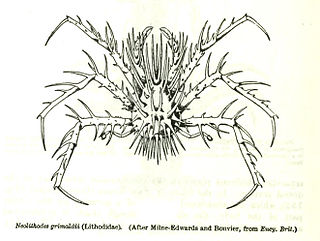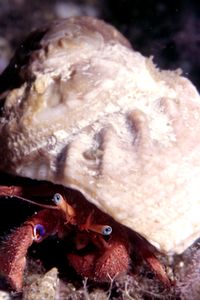
The Japanese spider crab is a species of marine crab that lives in the waters around Japan. It has the largest known leg-span of any arthropod.The Japanese name for this species is taka-ashi-gani,, literally translating to “tall legs crab”. It goes through three main larval stages along with a prezoeal stage to grow to its great size.

Cancer pagurus, commonly known as the edible crab or brown crab, is a species of crab found in the North Sea, North Atlantic Ocean, and perhaps the Mediterranean Sea. It is a robust crab of a reddish-brown colour, having an oval carapace with a characteristic "pie crust" edge and black tips to the claws. A mature adult may have a carapace width up to 25 centimetres and weigh up to 3 kilograms. C. pagurus is a nocturnal predator, targeting a range of molluscs and crustaceans. It is the subject of the largest crab fishery in Western Europe, centred on the coasts of the British Isles, with more than 60,000 tonnes caught annually.

Portunus pelagicus, also known as the flower crab, blue crab, blue swimmer crab, blue manna crab or sand crab is a species of large crab found in the Indo-Pacific, including off the coasts of Indonesia, Malaysia, Cambodia, Thailand, the Philippines, and Vietnam; and in the intertidal estuaries around most of Australia and east to New Caledonia.

The black dogfish is a species of dogfish shark in the family Etmopteridae. It is common over the outer continental shelf and continental slope at depths of 180–2,250 m (590–7,380 ft). Females generally inhabit deeper water than males, and depending on the region, smaller sharks may occur at different depths than larger ones. This species is distributed widely in the Atlantic Ocean, from Greenland and Iceland to Virginia and West Africa in the north, and off southwestern Africa and Argentina in the south. The largest member of its family, the black dogfish, typically measures 60–75 cm (24–30 in) long. It has a stocky, dark brown body that is darker below than above, and bears scattered, minute bioluminescent organs. Its two dorsal fins are preceded by stout spines, and the anal fin is absent.

The deepsea lizardfish, Bathysaurus ferox, is an aulopiform of the family Bathysauridae, found in tropical and subtropical seas across the world. The deepsea lizardfish should not be confused with the true or "typical" lizardfishes of the related family Synodontidae.

The Jonah crab is a marine brachyuran crab that inhabits waters along the east coast of North America from Newfoundland to Florida. Jonah crabs possess a rounded, rough-edged carapace with small light spots, and robust claws with dark brown-black tips. The maximum reported carapace width for males is 222 mm, while females rarely exceed 150 mm. It is the closest relative to the European brown crab in the Western Atlantic.
This is a glossary of terms used in fisheries, fisheries management and fisheries science.

Eriphia verrucosa, sometimes called the warty crab or yellow crab, is a species of crab found in the Black Sea, Mediterranean Sea and eastern Atlantic Ocean from Brittany to Mauritania and the Azores. Individual crabs have been caught as far north as Cornwall. Formerly a frequent species in the Black Sea, it has decreased in numbers since the 1980s and is now listed in the Ukrainian Red Data Book of endangered species.

Paralithodes platypus, the blue king crab, is a species of king crab from cold waters in the North Pacific Ocean and adjacent seas. Although blue king crabs are among the largest crabs in the world and reputedly may exceed 18 pounds (8.2 kg) in weight, they are generally smaller than red king crabs.

Pilumnus hirtellus, the bristly crab or hairy crab, is a species of European crab. It is less than 1 inch (25 mm) long and covered in hair. It lives in shallow water and feeds on carrion.

Pisidia longicornis, the long-clawed porcelain crab, is a species of porcelain crab that lives in the north-eastern Atlantic Ocean. It varies from reddish to white, and grows to a carapace width of 1 cm (0.4 in). It was first named by Carl Linnaeus in 1767, although the etymology remains unclear.

Chionoecetes opilio, a species of snow crab, also known as opilio crab or opies, is a predominantly epifaunal crustacean native to shelf depths in the northwest Atlantic Ocean and north Pacific Ocean. It is a well-known commercial species of Chionoecetes, often caught with traps or by trawling. Seven species are in the genus Chionoecetes, all of which bear the name "snow crab". C. opilio is related to C. bairdi, commonly known as the tanner crab, and other crab species found in the cold, northern oceans.
Hypothalassia acerba is a large crab found in the muddy substrates of the deep seas off the southwestern Australian and New Zealand coasts. Australian distribution, which is correlated to depth and temperature, ranges from a latitude as far north as approximately 27° S on the west coast, southwards, then eastwards on the south coast to a longitude of at least 129° E. The species usually occurs in waters with temperatures of 13–19 °C (55–66 °F) and in depths ranging of 200–255 metres (656–837 ft) on the lower west coast and 90–200 m (300–660 ft) on the south coast. Body size is inversely related to depth of water. There are only two species in the genus Hypothalassia, and H. acerba is not the same champagne crab as the other Hypothalassia species, H. armata, which is found in Japanese waters.
Libinia ferreirae is a species of tropical spider crab in the family Epialtidae. It is found on the seabed in shallow waters off the Atlantic coast of South America.

Pyromaia tuberculata is a species of crab in the family Inachoididae.

Geryon trispinosus is a species of crab that lives in deep water in the north-eastern Atlantic Ocean.

Neolithodes grimaldii, the porcupine crab, is a species of king crab in the family Lithodidae. This large red crab is found in cold deep waters in the North Atlantic and often caught as a bycatch in fisheries for Greenland turbot. As suggested by its common name, the carapace and legs are covered in long spines.

Paguristes eremita, the eye spot hermit crab, is a species of hermit crab in the family Diogenidae. It is found in the Mediterranean Sea.

The horsehair crab, Erimacrus isenbeckii, is a species of crab which is found mainly in the Northwest Pacific, around the Hokkaido coast in the Sea of Okhotsk and the Western Bering Sea and is an important commercial species used in Japanese cuisine. Despite the importance of the species, biological studies are usually specialized and limited. The catch for the species reached a peak in the 1950s at 27,000 tons and has decreased since, reaching 2,000 tons in 2003. Due to the commercial importance of the species, many stock enhancement programs have been utilized to help maintain a successful fishery. The species is commonly found on sandy benthic environments from shallow water to depths of up to 350 meters.

Hepatus pudibundus, the flecked box crab, is a crab from the class Malacostraca. They are found in the Atlantic Ocean with Brazil having a dense population of H. pudibundus, as they are one of the most commonly seen crabs in the country. Many of the studies done on H. pudibubus have occurred in the Ubatuba region of Brazil, where there is a rapid expansion of tourism that is affecting marine ecosystems.


















